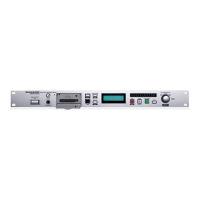3
ENGLISH
• Playback aids
A common problem with lengthy voice or other recordings
is difficulty in locating one or more specific passages for
playback. The PMD560 has several ways to mark specific
record starting points.
• Tracks
• A new track (file) is automatically started each time you
begin a recording.
• It is not possible to record over a previously recorded
track unless it is first erased.
• An Auto Track feature can add tracks every minute or
other selected recording intervals. (Minute track: Setting
the interval to one minute provides a new track every
minute of a recording. This permits navigation of a large
audio recording by time.)
• A new track can be started during recording by pressing
the REC button (if the "Manual Trk" preset is turned
On).
• EDL marks*
EDL (Edit Decision List) marks can be created during
recording manually or automatically. EDL marks help you
find specific points in the recording.
• During playback, you can instantly locate EDL marks.
• Up to 255 EDL marks can be added to a CF card. EDL
marks are numbered consecutively starting at one.
During recording, you can manually add an EDL mark
by pushing and holding the SHIFT button While you
push the REC/MARK button. EDL marks can also be
added automatically.
*The EDL marking system is proprietary to Marantz
Professional solid state recorders.
• Virtual Track
Virtual Track allows you to set an in point and an out point
within a file for later immediate playback access.
• Copy Segment
Copy Segment works just like the copy and paste function
of your standard word processing program. It allows you
to "highlight" a section of a track(file) by setting an in point
and an out point, and then paste that section into a new
track(file) without destroying the original track(file).
• Setup
Three menu selectable Presets make it easy to switch
between your commonly used input, recording format and
other menu selections.
• Time / Date stamp
A built-in date and time generator marks (stamps) the
beginning of each track.
Introduction
Thank you for selecting the Marantz Professional PMD560
Solid State Recorder.
The PMD560 is an audio recorder that records in digital
audio formats onto a Compact Flash™ memory card (CF
card) or Microdrive™.
CF cards, also used in digital cameras, are widely available
at consumer electronics retailers and computer resellers.
Features
• Stereo (2 channels) and mono (1 channel) audio
recording and playback.
• Audio inputs may be from :
• line level audio sources connected to the LINE IN jack.
• Audio outputs may be from :
• headphones connected to the HEADPHONE jack, or
• analog audio devices such as an amplifier or other
devices connected to the LINE OUT jack.
• Records onto various types of CF cards.
(Please refer to the Marantz Professional web site
www.d-mpro.com for what kind of media are
recommended.)
• Computer compatible
The PMD560 records directly onto CF cards. Recordings
can be transferred to your desktop or laptop computer by
removing the CF card from the PMD560 or by connecting
the PMD560 to your computer via the USB port. Audio
recorded in the popular MP3 compression format is
directly available for intranet or internet file sharing.
• MS-DOS™ and Windows compatible file system.
• Automatic recording
The PMD560 can be set to stop recording when there is
silence (Silent Skip) and automatically start when sound
resumes. The PMD560 can be set to automatically add
an EDL mark to the track at each such starting point.
• Two different recording formats :
• Compressed recording using MPEG1 Layer III (MP3)
mono and stereo.
MP3 compressed at 128kbps (stereo) or 64kbps (mono).
• Uncompressed recording using 16-bit linear Pulse Code
Modulation (PCM).
• Three remote options, including RS-232C, permit wired
remote control.
• Security – CF cards
For security, the CF card compartment door can be
secured with a screw. Requiring a tool to open the CF
card compartment reduces casual removal of the CF
card.
• Pre-Recording memory buffer records 2 seconds of audio
before recording is started.

